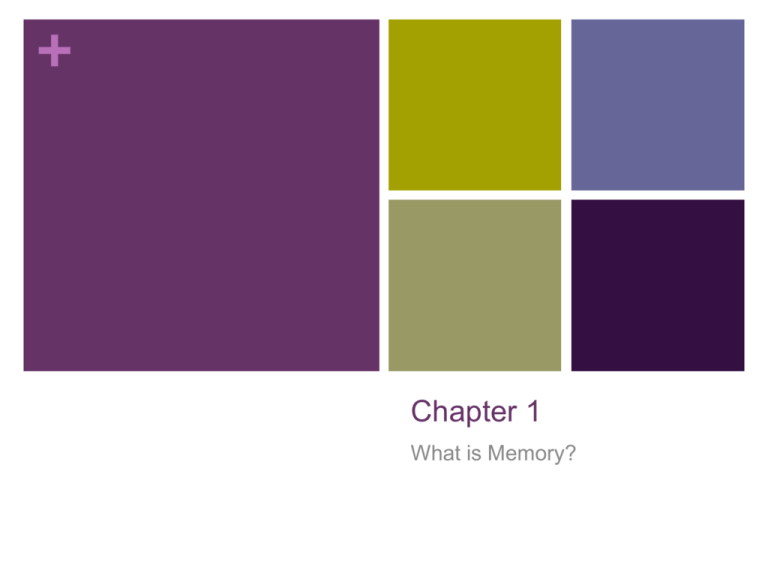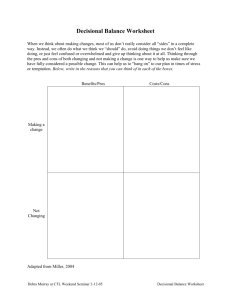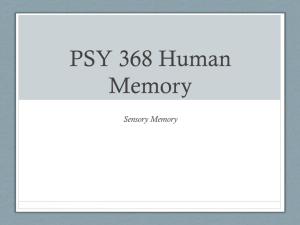
+
Chapter 1
What is Memory?
Psychological Theories
Theories are comparable to maps, helping to:
Summarize knowledge in a simple and structured manner
Pose new, testable questions that advance further discovery
Theories, like maps, can be specialized to address questions
on a variety of related levels of explanation, which can
sometimes inform other levels, through a process called
reductionism:
Awareness
Processes
Neurons
m
Reductionism
+
The practice of explaining
complex phenomena in terms
of lower-level processes
Molecules
Atoms
+
A Brief History of Learning and
Memory
Concurrent
+
19th Century Germany
Ebbinghaus
(1850-1909)
Nonsense syllables
PIM DAG ZOL CEK
Learning curve – massed vs spaced practice
Forgetting curve – forgetting occurs rapidly
Overlearning – studying after something is learned
Savings – decreased effort needed to relearn
Bartlett
(1886-1969) – a critic
How does prior knowledge influence memory
Reconstruction is guided by schemas (concepts)
+
Ebbinghaus Forgetting Curve
+
Importance of Practice
The more repetition (practice), the more likely
information is to be remembered later.
Slide
10/07/08
+
Massed vs Spaced Study
Ebbinghaus, H. Memory: A contribution to
experimental psychology. New York:
Dover, 1964 (Originally published, 1885).
Keppel, Geoffrey. A Reconsideration of the
Extinction-Recovery Theory. Journal of
Verbal Learning & Verbal Behavior. 6(4)
1967, 476-486
+ Bartlett’s “War of the Ghosts”
Bartlett
(1932) used multiple repetition of recalled
material to study distortions over time.
Participants
were given a 328 word Native American
folk tale “The War of the Ghosts” to read twice and
then reproduce 15 minutes later and also hours to
months later.
Total recall declined.
What was recalled was shaped by the need to form a
coherent understandable story in the context of their own
cultural knowledge (schemata – concepts).
He considered memory an active process of construction.
+
Contributions of Gestalt
Psychology
Gestalt
The
movement (Kohler, Koffka, Wertheimer)
whole is different that the sum of its parts.
Anti-reductionistic
But they did acknowledge the importance of
understanding the components of thought.
Memory
is influenced by the configuration of
elements and context.
Isomorphism
of mental representation – material is
represented mentally in the same configuration as
it exists in the world.
+
Behaviorism
Behaviorism
(Pavlov, Thorndike)
Psychology
should be the study of observable
behavior not structure of mind.
Behaviorism is associated with the term “learning”.
Later behaviorists (like Tolman) used mental
explanations and representations (e.g., cognitive
maps).
Classical
and operant conditioning both
depend upon memory – associations are
remembered.
+
Verbal Learning
A
behaviorist approach to the learning of
verbal materials (words, sentences,
stories).
Developed
from Ebbinghaus’s work.
Memorization
is the “attachment of
responses to stimuli.”
Forgetting
is the “loss of response
availability.”
+
Paired Associates Paradigms
Paired
associate learning – people
memorize pairs of items (BIRD-GLOVE):
A
B
A-B -- the first item (A) is the cue and the second item (B) is
the response
A-B C-D paradigm (two lists are learned)
A-B A-D paradigm (two associations learned to one cue)
A-B A-B’ paradigm (B and B’ are synonyms)
A-B A-Br paradigm (Br is a response previously associated
with a different cue – these recombinations are hard!)
+
Sample Paired Associate Task
In the learning
phase subjects see
pairs of items.
In the test phase
subjects see one item
of the pair and must
identify the other.
Stimuli can be visual (like these) or verbal (pairs of words)
+
Early Neuroscience -- Lashley
Lashley
(1890-1958) searched for the brain
engram (the physical memory trace).
First,
rats learned a maze.
Next,
Lashley progressively removed
larger and larger portions of rats brains
from different locations and tested them in
the maze to see how memory changed.
Memory
was affected more by the amount
of brain tissue removed, not the location.
+ Hebb’s Theory
Hebb
(1949) proposed that cortical
organization occurs through “cell assemblies”
and “phase sequences.”
Cell
assembly -- a set of associated neurons that work
together because they are activated together.
Phase sequences incorporate several cell
assemblies. They form systems involving multiple
interconnected areas of the brain.
Repeated stimulation produces structural changes at
the synaptic level – Hebb’s rule: “What fires together
wires together”
+
The Cognitive Revolution
Thought
is a valid subject for study
This
is the field of psychology associated with
the term “memory”
Cognitive
psychologists adopted the
methodological rigor of the behaviorists.
The
computer metaphor
hardware (brain) vs. software (thought
processes)
+
Three Definitions of Memory
1.
The location where memory is stored.
2.
The physical entity that holds the
memory:
a)
b)
3.
Trace
Engram
The processes used to acquire (learn),
store (encode) or remember (retrieve)
information.
+
Metaphors for Memory
Recorder
of
experience
Wax tablet
Record player
Writing pad
Tape recorder
Video camera
Organized
House
Library
Dictionary
storage
Interconnections
Switchboard
Network
Jumbled
Birds
Storage
in an aviary
Purse
Junk
drawer
Garbage can
+
Metaphors Emphasizing Specific
Aspects of Memory
Temporal
Availability
Conveyor belt
Content
Addressability
Lock and key
Tuning fork
a dinosaur
of Details
Leaky bucket
Cow’s stomach
Acid bath
Active
Reconstruction
Rebuilding
Forgetting
processing
Workbench
Computer
program
+
The Information Processing
Metaphor
Like a computer, human memory consists of three
interacting components:
+
Atkinson and Shiffrin's (1968)
Modal Model
Unlike a unitary, associative memory system, the modal model
assumes multiple memory structures:
Information from the external environment is perceived and then very briefly
stored in sensory memory, which is considered to be a perceptual, rather than
a purely mnemonic process
Information is then passed to a limited-capacity, short-term memory store
Finally, information can be encoded in the unlimited long-term store, more or
less permanently
Evidence now suggests that the information flow is actually bidirectional
+
22
Sensory Memory
The perceptual system stores the most
recently acquired static image just long
enough to integrate it with the next, in
order to create apparent motion
Sperling (1960) investigated the number
of items available for report in visual
memory by randomly sampling items from
a matrix of letters presented to
participants
Recall decreases when:
The delay between the original
presentation and the signal indicating
which items from the matrix to report is
increased
A visual mask (e.g. a bright flash of light or
a contoured pattern) is presented
following the matrix display, thereby
interfering with the memory trace
A medium auditory tone
signals subjects to report
letters on the middle line
of the matrix.
+
Iconic Memory
Estimated number of letters available using the partial report method,
as a function of recall delay. From Sperling (1963). Copyright © 1963
by The Human Factors and Ergonomics Society. All rights reserved.
Reproduced with permission.
+
Echoic Memory
Serial recall of a nine-item list when an additional item, the
suffix, is either the spoken word zero or a sound made by a
buzzer. From Crowder (1972). Copyright © 1972 Massachusetts
Institute of Technology by permission of the MIT Press.
+
A Two-Step Process
Iconic
Memory
Peripheral
Visual Store
100 letters per second
read out
Recognition
Buffer
More durable but also
much slower
+
Do Iconic and Echoic Memory
Function Similarly?
Both
forms of memory show interference by masking
(lights or extra sounds at the end of the presentation).
Echoic memory is disrupted by a final speech sound but
not a buzzer.
Iconic memory is disrupted by a final light mask but not a
dark mask, and by masks that interfere with perception.
Iconic
memory shows a primacy effect whereas echoic
memory shows a recency effect – perhaps due to a
precategorical acoustic store important to speech
perception.
+
Short-Term Memory (STM) and
Working Memory (WM)
Short-Term Memory (STM): The temporary storage of small
amounts of material over brief delays
While initially thought to be primarily verbal in nature, STM can hold
material from almost any modality, including from the visuo-spatial
domains
It is thought that rehearsal is often used to maintain items in the
short-term store
Working Memory (WM): A mental workspace, linked to
attention, which provides a basis for thought and the symbolic
manipulation of items being held within this temporary store
+
Multiple Memory Systems
Memory
is not unitary but consists of several
subcomponents (parts).
Tulving’s Triarchic Theory:
Episodic
Autonoetic (self)
Semantic
Noetic (formal knowledge)
Procedural
Anoetic (automatic skills)
Squire’s Implicit vs Explicit Theory:
Implicit
Unconscious
Explicit
Conscious
Declarative
+
Long Term Memory
Components of long-term memory as proposed by Squire
(1992a).
Slide
10/07/08
+
Long-Term Memory (LTM)
Explicit/Declarative Memory:
Long-term memory for facts and
events
Episodic Memory: Memory for
specific events that can be vividly
recalled through what Tulving calls
“mental time travel”
e.g. I celebrated my last
birthday in Madrid
Semantic Memory: General
knowledge of the world and
society
e.g.The capital of Spain is
Madrid
Implicit/Non-Declarative or
Procedural Memory: Longterm memory for information
that is reflected through
performance, rather than overt
remembering
e.g. Motor skills like learning
to ride a bike, classical
conditioning, and priming
Priming: An unconscious
tendency to recall a
previously seen or related
item
+
Long-Term Memory
Amnesia
One indication that long-term memory can be subdivided into
distinct systems comes from the study of people with amnesia.
Amnesia is a memory disorder that can have psychological
(functional) or physical (organic) causes.
Regardless of cause, amnesics typically:
Have significant impairments in episodic encoding/retrieval
Have difficulties forming new semantic memories
This suggests that semantic memories are normally formed by
generalizing information first encoded episodically
Have a preserved (unimpaired) ability to acquire and use implicit
memories
+
Memory In and Out of the
Laboratory
Researching in the Laboratory
Pros:
More experimental control
Easier to develop and
rigorously test theories in
rapid succession
Cons:
Overrepresentation of
certain participant
populations (students)
Reduced generalizability
of findings
Less ecological validity
(not like real life)
Researching in the Real World
Pros:
Validates theory by testing various
populations while advancing
therapeutic treatments
Highlights important gaps in
current understanding and
advances future theory
development
Cons:
Less experimental control; more
confounding variables
Harder to isolate causes of
observed phenomena
+
Neuropsychological Studies of
Memory
Disease-Related Studies
Involves characterizing the
deficits and preserved abilities
in patients suffering from
specific diseases (e.g.
Alzheimer’s)
Pros:
Provides a direct route to
advancing diagnosis and
treatment of diseases
Cons:
Often difficult to separate
memory impairments from
other deficits related to the
disease
Lesion Studies
Involves profiling patients with
organic brain damage to
relatively focal regions (like
HM’s hippocampal lesions)
Pros:
Helps identify causal links
between brain and behavior
Cons:
Such cases are relatively
rare
Lesions are almost never
entirely confined to a specific
region of interest and/or
patients’ deficits are not
entirely pure
+
The Human Brain
+
Electroencephalography (EEG)
Since the early 1900s, researchers have used electrodes
placed on the scalp to record the electrical signals generated
by the brain’s neurons
The characteristics of the continuous brainwaves can help identify
abnormal brain activity and different stages of sleep and arousal
By dividing the continuous wave into segments called evoked
response potentials or event-related potentials (ERPs), each
beginning with a particular event, one can characterize the response
elicited by that particular occurrence
Pros:
Millisecond temporal resolution
Relatively low cost to perform and non-invasive
Cons:
Inability to precisely locate the brain region generating the
recorded signal
+
Neuroimaging Techniques
The use of newly developed technologies that allow researchers
to study the structure and function of the brain by tracking
indicators of brain activity
+
Current Issues
Neurological
bases for memory
Impact
and importance of emotion on
memory
Use
of multiple memory sources (fuzzy
trace theories)
Embodied
cognition – how our grounding
in the world influences memory








